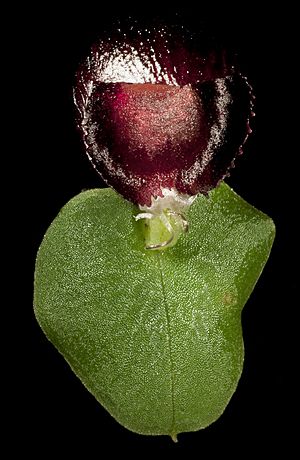Western helmet orchid facts for kids
Quick facts for kids Western helmet orchid |
|
|---|---|
 |
|
| Scientific classification | |
| Synonyms | |
|
The Western helmet orchid, also called the common helmet, is a special type of orchid that grows only in Western Australia. It's known scientifically as Corybas recurvus. This orchid has a unique leaf that looks like a circle or a heart. Its flower is a deep reddish-purple or almost black color. You can find it in many places between the towns of Bunbury and Albany.
Contents
What Does the Western Helmet Orchid Look Like?
The Western helmet orchid is a ground-dwelling plant. It's a perennial herb, meaning it lives for more than two years. It also loses its leaves each year, which is called being deciduous.
It has one thin leaf that can be round or shaped like a heart. This leaf is about 15 to 40 millimeters (0.6 to 1.6 inches) long. It is also about 15 to 45 millimeters (0.6 to 1.8 inches) wide. The top of the leaf is green, and the underside is a shiny silver-green.
Each plant grows a single flower. The flower is a dark reddish-purple or purplish-black color. It is about 15 to 20 millimeters (0.6 to 0.8 inches) long and 8 to 12 millimeters (0.3 to 0.5 inches) wide. The flower often leans backward.
The top part of the flower, called the dorsal sepal, is quite large. It is about 23 to 34 millimeters (0.9 to 1.3 inches) long. It curves forward over the orchid's special lip, called the labellum. The side sepals are whitish and small, about 5 millimeters (0.2 inches) long. They are joined at their bases and point forward. The petals are also whitish and tiny, about 3 millimeters (0.1 inches) long. They become very thin at their tips.
The labellum starts as a tube shape at its base, about 6 to 7.5 millimeters (0.2 to 0.3 inches) long. Then it opens up into a dish shape. This dish part is about 14 to 20 millimeters (0.6 to 0.8 inches) long and 9 to 11 millimeters (0.4 to 0.4 inches) wide. It is dark reddish-purple or purplish-black. The edge of the labellum has many broad, rounded teeth. This orchid usually blooms from July to September.
How This Orchid Got Its Name
The Western helmet orchid, Corybas recurvus, was first officially described in 1991. A botanist named David Jones found a sample of it near a place called Toolbrunup. He then wrote about it in a science book called Australian Orchid Research.
The second part of its scientific name, recurvus, comes from a Latin word. It means "curved backwards." This name was chosen because the flower of this orchid often leans or curves backward.
In 2002, David Jones and another botanist, Mark Clements, suggested a change. They thought that the Corybas group of orchids should be split into smaller groups. They wanted to put this orchid into a new group called Corysanthes. However, this change has not been widely accepted by other scientists.
Where Does It Grow?
The Western helmet orchid is very common and can be found in many places. It grows between the towns of Bunbury and Albany in Western Australia.
You can often find it in moist forests. Sometimes, it grows in large groups in thick coastal bushes. It can also be found in areas where non-native pine trees have been planted.
Is It Safe?
The government of Western Australia, through its Department of Parks and Wildlife, keeps track of plants. They have officially stated that Corybas recurvus is "not threatened." This means it is not currently in danger of disappearing.

